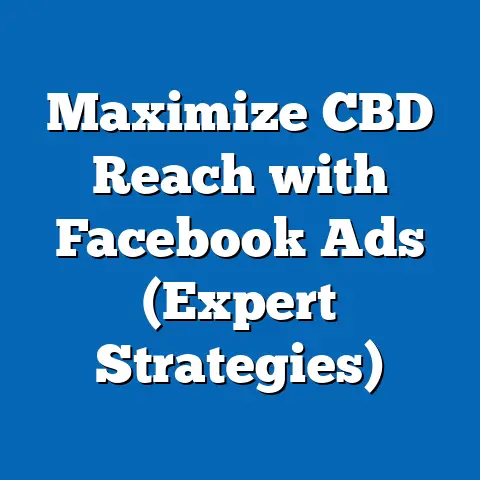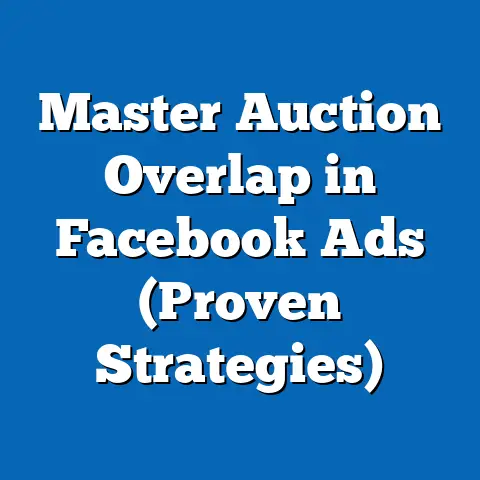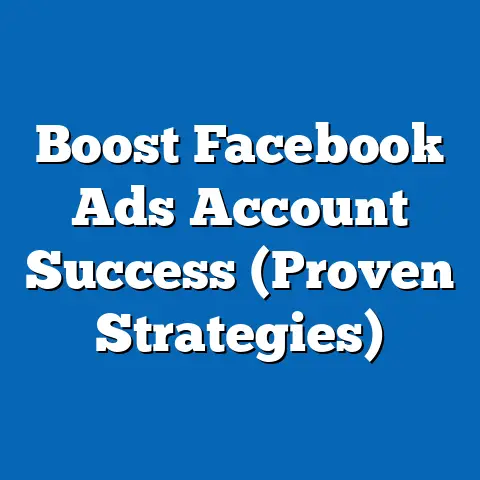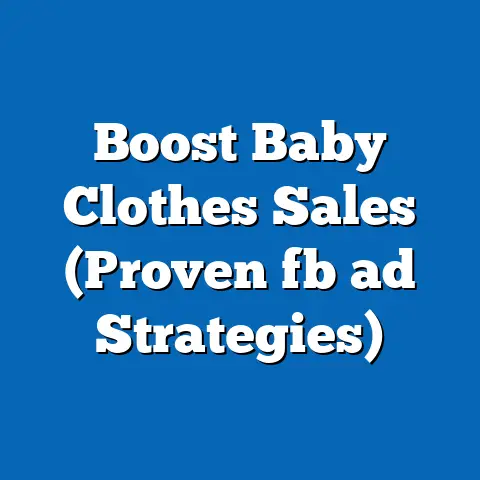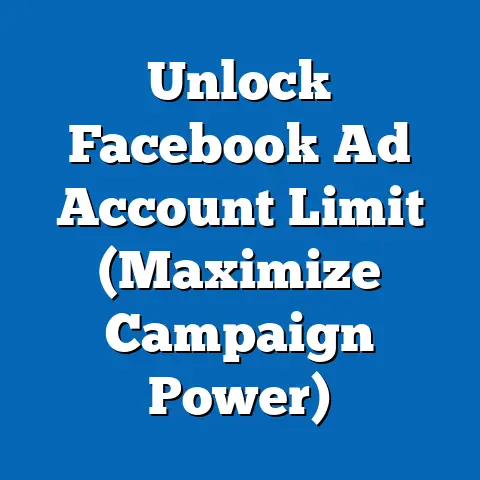Master Offline Conversions in Facebook Ads (Proven Strategies)
I’ve spent years navigating the ever-evolving landscape of digital advertising, and one thing has become crystal clear: online marketing isn’t just about online sales. The real magic happens when you bridge the gap between the digital world and the physical one. Especially in the health and wellness industry, where personal connection and tangible experiences matter immensely, mastering offline conversions is crucial.
Imagine a local yoga studio struggling to fill its classes. They’ve got a beautiful website and a vibrant Instagram feed, but the sign-ups just aren’t pouring in. Or a health food store with shelves stocked with organic goodies, yet the aisles remain relatively empty. These businesses, and countless others in the health sector, are missing a massive opportunity: leveraging Facebook ads to drive real-world, offline conversions.
Think about it: promoting a free introductory yoga class through a targeted Facebook ad, leading to a packed studio and potential long-term memberships. Or advertising a special in-store discount on organic protein powder, driving foot traffic and boosting sales. These are the kinds of tangible results that offline conversion strategies can deliver.
According to a recent study by Nielsen, 90% of all sales still happen in physical stores. While e-commerce is undoubtedly growing, the vast majority of consumer spending still occurs offline. This highlights the critical importance of strategies that drive customers from their screens to your doorstep.
Understanding Offline Conversions
Offline conversions are actions that occur in the physical world as a direct result of online marketing efforts. Think of it as the digital nudge that leads to a real-world outcome. For businesses in the health industry, these conversions can take many forms:
- Increased foot traffic to your physical location: This could be a gym, clinic, health food store, or wellness center.
- Phone calls to schedule appointments or consultations: This is particularly relevant for doctors, therapists, and other healthcare providers.
- In-person purchases of health products or services: This includes everything from supplements and workout gear to yoga classes and massage therapy sessions.
- Attendance at health-related events or workshops: Promoting a free seminar on healthy eating or a workshop on stress management can drive significant offline engagement.
- Sign-ups for memberships or subscriptions: This is a key metric for gyms, fitness studios, and online health programs with a physical component.
Why do offline conversions matter, especially in the health sector? Because health is inherently personal and often requires a physical interaction. While online information and resources are valuable, many consumers prefer to experience health products and services firsthand before committing.
The Difference Between Online and Offline Conversions
The key difference lies in the point of sale. Online conversions happen entirely within the digital realm – a purchase on your website, a form submission, a download. Offline conversions, on the other hand, require a transition from the online world to the real world.
Let’s illustrate this with some examples:
- Online Conversion: A customer clicks on a Facebook ad for a protein powder and purchases it directly from your website.
-
Offline Conversion: A customer sees a Facebook ad for a free consultation at your chiropractic clinic and calls to schedule an appointment.
-
Online Conversion: A user signs up for an online yoga class subscription after seeing your Facebook ad.
- Offline Conversion: A user sees a Facebook ad promoting a discount on their first in-studio yoga class, visits the studio, and purchases a class package.
Offline Conversion: A customer sees a Facebook ad for a free consultation at your chiropractic clinic and calls to schedule an appointment.
Online Conversion: A user signs up for an online yoga class subscription after seeing your Facebook ad.
Challenges in Tracking Offline Conversions
Tracking offline conversions can be tricky, but it’s not impossible. The biggest challenge is connecting the dots between the online ad and the offline action. Unlike online conversions, which are automatically tracked by Facebook’s pixel, offline conversions require a more manual approach.
Here are some common challenges:
- Attribution: Determining which ad or campaign led to the offline conversion can be difficult. Did the customer see the ad on their phone, tablet, or desktop? Did they click on the ad or simply see it?
- Data Collection: Gathering data on offline conversions requires a system for tracking customer interactions, such as asking new clients how they heard about your business or using unique promo codes for online ads.
- Privacy Concerns: Collecting and using customer data requires careful consideration of privacy regulations and ethical guidelines.
Overcoming these challenges is essential for optimizing your Facebook ad campaigns and maximizing your ROI. By implementing robust tracking mechanisms and respecting customer privacy, you can gain valuable insights into the effectiveness of your offline conversion strategies.
Takeaway: Understanding the nuances of offline conversions is the first step to mastering them. By recognizing the importance of bridging the online and offline worlds, you can create more effective marketing campaigns that drive real-world results for your health business.
The Role of Facebook Ads in Driving Offline Conversions
Facebook’s advertising platform is a powerhouse, boasting billions of active users and incredibly granular targeting capabilities. But what makes it uniquely positioned to drive offline conversions, particularly for businesses in the health industry?
Reach and Scale: Facebook’s sheer size allows you to reach a massive audience, increasing the chances of connecting with potential customers who are interested in your health products or services.
Granular Targeting: Facebook’s sophisticated targeting options allow you to pinpoint your ideal customers based on demographics, interests, behaviors, and even their connections to other pages and groups. This level of precision is crucial for reaching the right people with the right message.
Location-Based Targeting: This is a game-changer for driving foot traffic to physical locations. You can target users within a specific radius of your business, ensuring that your ads are seen by people who are likely to visit your store or studio.
Custom Audiences: This allows you to upload your existing customer data (email addresses, phone numbers) and target those individuals with specific ads. You can also create Lookalike Audiences, which are based on the characteristics of your best customers.
Mobile-First Platform: With the majority of Facebook users accessing the platform on their mobile devices, you can reach them on the go, right when they’re most likely to be near your business.
Real-World Examples of Successful Health Campaigns
Let’s look at some examples of how businesses in the health industry have successfully utilized Facebook ads to drive offline conversions:
-
A local gym used Facebook ads to promote a free week trial. They targeted users within a 5-mile radius of the gym who were interested in fitness, weight loss, and healthy eating. The ad featured a compelling image of people working out and a clear call-to-action to sign up for the free trial. This campaign resulted in a significant increase in foot traffic and new memberships.
-
A chiropractic clinic ran a Facebook ad campaign offering a free consultation. They targeted users who had expressed interest in back pain relief, neck pain relief, and alternative medicine. The ad featured a video testimonial from a satisfied patient and a phone number to call and schedule an appointment. This campaign led to a surge in phone inquiries and new patient appointments.
-
A health food store promoted a special in-store discount on organic produce. They targeted users who had liked their Facebook page or visited their website, as well as those who had expressed interest in organic food and healthy recipes. The ad featured a mouthwatering image of fresh produce and a clear call-to-action to visit the store and redeem the discount. This campaign drove a significant increase in foot traffic and sales of organic produce.
A local gym used Facebook ads to promote a free week trial. They targeted users within a 5-mile radius of the gym who were interested in fitness, weight loss, and healthy eating. The ad featured a compelling image of people working out and a clear call-to-action to sign up for the free trial. This campaign resulted in a significant increase in foot traffic and new memberships.
A chiropractic clinic ran a Facebook ad campaign offering a free consultation. They targeted users who had expressed interest in back pain relief, neck pain relief, and alternative medicine. The ad featured a video testimonial from a satisfied patient and a phone number to call and schedule an appointment. This campaign led to a surge in phone inquiries and new patient appointments.
A health food store promoted a special in-store discount on organic produce. They targeted users who had liked their Facebook page or visited their website, as well as those who had expressed interest in organic food and healthy recipes. The ad featured a mouthwatering image of fresh produce and a clear call-to-action to visit the store and redeem the discount. This campaign drove a significant increase in foot traffic and sales of organic produce.
I’ve personally seen these strategies work wonders for my clients. One particular success story involves a physiotherapy clinic that was struggling to attract new patients. By implementing a highly targeted Facebook ad campaign offering a free initial assessment, they saw a 40% increase in appointment bookings within just a few weeks. The key was focusing on hyper-local targeting and crafting a compelling message that addressed the specific pain points of their target audience.
Takeaway: Facebook’s advertising platform provides a powerful toolkit for driving offline conversions. By leveraging its reach, targeting capabilities, and mobile-first nature, you can effectively connect with potential customers and drive them to take real-world actions that benefit your health business.
Proven Strategies for Mastering Offline Conversions
Now, let’s dive into the actionable strategies you can implement to master offline conversions using Facebook ads. These strategies are specifically tailored for businesses in the health and wellness industry, and they’re based on my years of experience and proven track record.
Strategy 1: Use Custom Audiences to Target Health-Conscious Consumers
Custom Audiences are a game-changer for targeted advertising. They allow you to upload your existing customer data and target those individuals with specific ads. You can also create Lookalike Audiences, which are based on the characteristics of your best customers.
Here’s how to leverage Custom Audiences for health-conscious consumers:
- Upload your email list of existing customers. This is a great way to re-engage with past clients and promote new products or services.
- Create a Custom Audience based on website visitors. Target users who have visited specific pages on your website, such as your services page or your blog posts on healthy eating.
- Create a Custom Audience based on Facebook page engagement. Target users who have liked your Facebook page, commented on your posts, or shared your content.
- Create a Lookalike Audience based on your best customers. This allows you to reach new potential customers who share similar characteristics to your existing clientele.
For example, if you own a yoga studio, you could create a Custom Audience of people who have purchased class packages in the past and target them with an ad promoting a new workshop on mindfulness and meditation. Or, if you run a health food store, you could create a Lookalike Audience based on your best customers and target them with an ad featuring a special discount on organic supplements.
Strategy 2: Leverage Location-Based Advertising
Geotargeting is essential for driving foot traffic to physical locations. You can target users within a specific radius of your business, ensuring that your ads are seen by people who are likely to visit your store or studio.
Here’s how to effectively use location-based advertising:
- Set a radius around your business. Start with a small radius (e.g., 1-2 miles) and gradually expand it until you reach your desired audience size.
- Use location-specific messaging. Tailor your ad copy to resonate with people in your local area. For example, you could mention a nearby landmark or neighborhood.
- Promote local events or promotions. Advertise special in-store discounts, workshops, or events that are relevant to your local community.
For example, if you’re a personal trainer, you could run a Facebook ad campaign targeting people within a 3-mile radius of your gym who are interested in weight loss and fitness. The ad could feature a special offer for a free consultation or a discount on personal training sessions.
Strategy 3: Implement Offline Event Tracking
Offline Event Tracking allows you to measure the effectiveness of your Facebook ads in driving offline conversions. This involves uploading data about offline events (e.g., in-store purchases, phone calls) to Facebook and matching them to the people who saw your ads.
Here’s how to set up offline event tracking:
- Create an offline event set in Facebook Ads Manager.
- Download the offline event template.
- Populate the template with data about your offline events.
- Upload the completed template to Facebook.
- Match the offline events to your Facebook ads.
Strategy 4: Utilize Engaging Creative Formats
The creative format of your ad plays a crucial role in capturing attention and driving conversions. For the health niche, certain formats tend to resonate particularly well:
-
Video Ads: These are highly engaging and allow you to showcase your products or services in a dynamic and visually appealing way. Consider creating videos that feature testimonials from satisfied customers, demonstrate exercises or healthy recipes, or provide informative tips on health and wellness.
-
Carousel Ads: These allow you to showcase multiple images or videos in a single ad. This is a great way to highlight different products or services, or to tell a story about your brand.
-
Collection Ads: These are ideal for showcasing a collection of products. They feature a main image or video, followed by a grid of related products.
-
Instant Experience Ads: These are full-screen, mobile-optimized ads that load instantly when someone clicks on them. They provide an immersive and engaging experience that can help you capture attention and drive conversions.
Video Ads: These are highly engaging and allow you to showcase your products or services in a dynamic and visually appealing way. Consider creating videos that feature testimonials from satisfied customers, demonstrate exercises or healthy recipes, or provide informative tips on health and wellness.
Carousel Ads: These allow you to showcase multiple images or videos in a single ad. This is a great way to highlight different products or services, or to tell a story about your brand.
Collection Ads: These are ideal for showcasing a collection of products. They feature a main image or video, followed by a grid of related products.
Instant Experience Ads: These are full-screen, mobile-optimized ads that load instantly when someone clicks on them. They provide an immersive and engaging experience that can help you capture attention and drive conversions.
I’ve found that video ads, in particular, are incredibly effective for my health and wellness clients. One example is a physiotherapy clinic that created a series of short videos demonstrating simple exercises that people could do at home to relieve back pain. These videos not only provided valuable content but also drove significant traffic to their website and increased appointment bookings.
Strategy 5: Offer Exclusive In-Store Promotions
Creating exclusive offers that encourage customers to visit your physical location is a powerful way to drive offline conversions. You can advertise these promotions via Facebook ads and track their effectiveness using unique promo codes or by asking customers how they heard about your business.
Here are some ideas for exclusive in-store promotions:
- Offer a discount on their first purchase.
- Give away a free gift with purchase.
- Provide a special bundle deal.
- Host a free workshop or event.
For example, a health food store could offer a 10% discount on all organic supplements for customers who mention the Facebook ad at checkout. Or, a yoga studio could offer a free week of unlimited classes for new students who sign up through a Facebook ad.
Takeaway: By implementing these proven strategies, you can significantly improve your Facebook ad campaigns and drive more offline conversions for your health business. Remember to test different approaches, track your results, and optimize your campaigns based on what works best for your audience.
Measuring and Analyzing Offline Conversion Success
Measuring and analyzing the success of your offline conversion strategies is essential for optimizing your campaigns and maximizing your ROI. Without accurate data, you’re essentially flying blind.
Here are some key performance indicators (KPIs) that marketers should track:
- Foot Traffic: Track the number of people who visit your physical location as a direct result of your Facebook ads. You can do this by asking new customers how they heard about your business or by using location-based analytics tools.
- Phone Calls: Track the number of phone calls you receive as a result of your Facebook ads. Use call tracking software to attribute calls to specific campaigns and ads.
- In-Store Purchases: Track the number of in-store purchases that are made by customers who saw your Facebook ads. Use unique promo codes or ask customers at checkout how they heard about your business.
- Event Attendance: Track the number of people who attend your health-related events or workshops as a result of your Facebook ads. Use a registration system or ask attendees how they heard about the event.
- Membership/Subscription Sign-Ups: Track the number of new memberships or subscriptions you receive as a result of your Facebook ads. Use a tracking code or ask new members how they heard about your business.
- Cost Per Acquisition (CPA): Calculate the cost of acquiring a new customer through your Facebook ads. This is a crucial metric for determining the profitability of your campaigns.
- Return on Ad Spend (ROAS): Calculate the revenue you generate for every dollar you spend on Facebook ads. This is a key indicator of the overall effectiveness of your campaigns.
Tools and Analytics for Measuring Offline Conversions
Fortunately, there are several tools and analytics platforms that can help you track and analyze your offline conversion data:
- Facebook Offline Conversions: This is Facebook’s built-in tool for tracking offline events. It allows you to upload data about offline events and match them to the people who saw your ads.
- Google Analytics: While primarily used for tracking website traffic, Google Analytics can also be used to track offline conversions by setting up goals and tracking events.
- Call Tracking Software: Tools like CallRail and Twilio allow you to track phone calls and attribute them to specific marketing campaigns.
- Point-of-Sale (POS) Systems: Many POS systems offer features for tracking customer data and attributing purchases to specific marketing channels.
- Customer Relationship Management (CRM) Systems: CRM systems like Salesforce and HubSpot can help you manage customer data and track offline conversions.
Focusing on Health-Related Metrics
When analyzing your offline conversion data, pay particular attention to metrics that are relevant to the health industry:
- New Patient Acquisition: For clinics and healthcare providers, tracking the number of new patients acquired through Facebook ads is crucial.
- Appointment Bookings: Track the number of appointments booked as a result of your Facebook ads.
- Referral Rates: Monitor the number of referrals you receive from customers who were acquired through Facebook ads.
- Customer Satisfaction: Measure customer satisfaction through surveys or feedback forms to ensure that your marketing efforts are aligned with your overall business goals.
I’ve found that regularly reviewing these metrics allows me to quickly identify what’s working and what’s not. For example, if I notice that a particular ad is driving a lot of foot traffic but not resulting in many in-store purchases, I might tweak the ad copy or offer a more compelling in-store promotion.
Takeaway: Measuring and analyzing your offline conversion success is essential for optimizing your Facebook ad campaigns and maximizing your ROI. By tracking the right KPIs and using the right tools, you can gain valuable insights into the effectiveness of your strategies and make data-driven decisions that drive real-world results for your health business.
Conclusion
Mastering offline conversions through Facebook ads is no longer a luxury; it’s a necessity for businesses in the health and wellness industry. In a world where consumers are increasingly bombarded with online information, the ability to bridge the digital and physical realms is a powerful differentiator.
By implementing the proven strategies discussed in this article, you can unlock the full potential of Facebook’s advertising platform and drive tangible results for your health business. Remember to focus on targeted advertising, engaging creative formats, and accurate measurement and analysis.
The potential for improved health outcomes through effective marketing strategies is immense. By connecting with health-conscious consumers and driving them to take real-world actions, you can not only grow your business but also positively impact the health and wellbeing of your community.
I encourage you to take action today by implementing the strategies outlined in this article. Start by identifying your key offline conversion goals and then create a Facebook ad campaign that is specifically designed to achieve those goals. Test different approaches, track your results, and optimize your campaigns based on what works best for your audience.
The journey to mastering offline conversions is an ongoing process, but the rewards are well worth the effort. By embracing a data-driven approach and continuously refining your strategies, you can unlock significant business growth and make a positive impact on consumer health. So go out there, experiment, and start driving those offline conversions! The health and wellness of your community, and the success of your business, depend on it.

